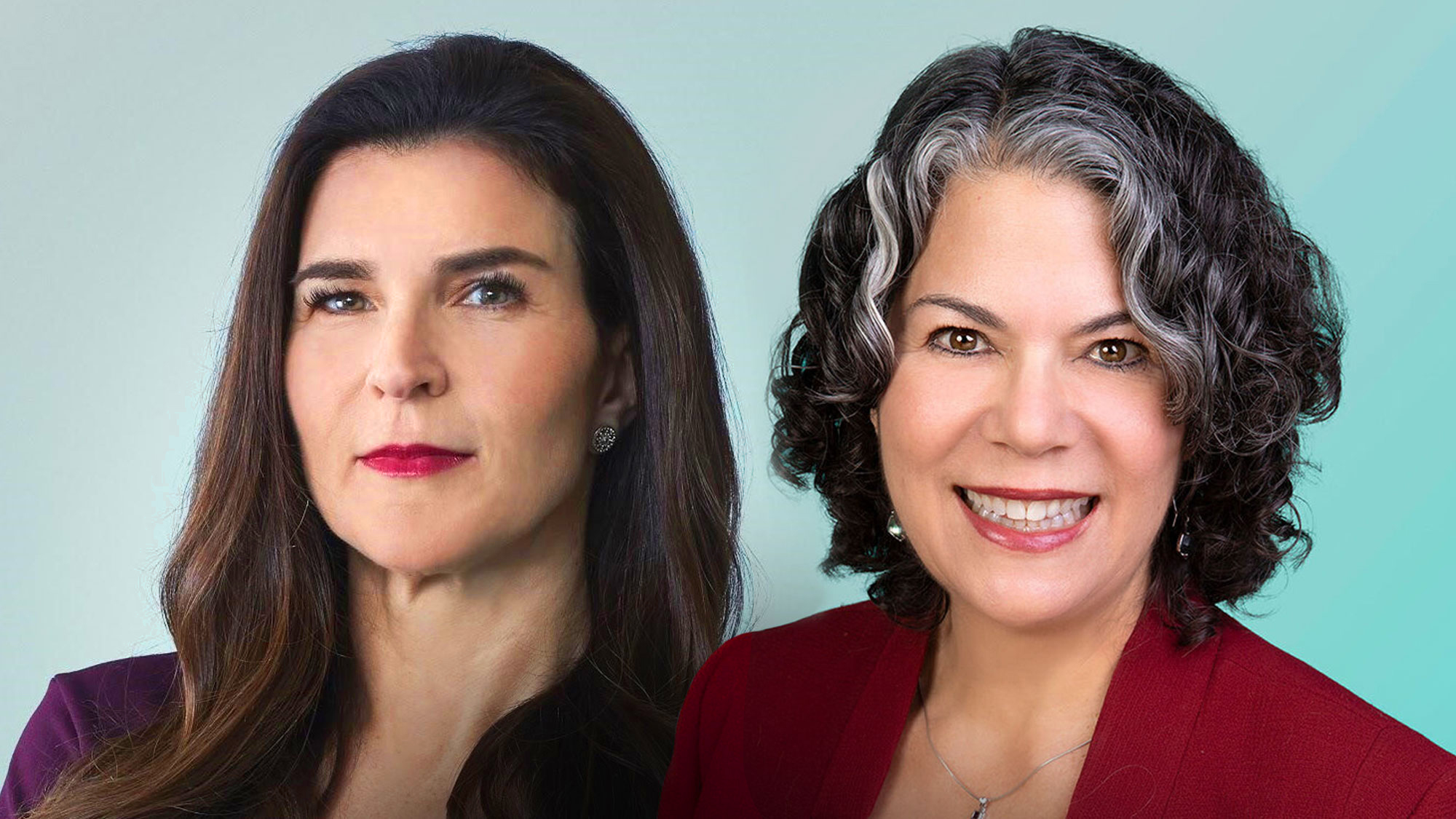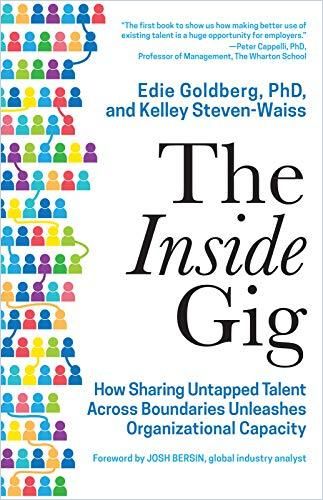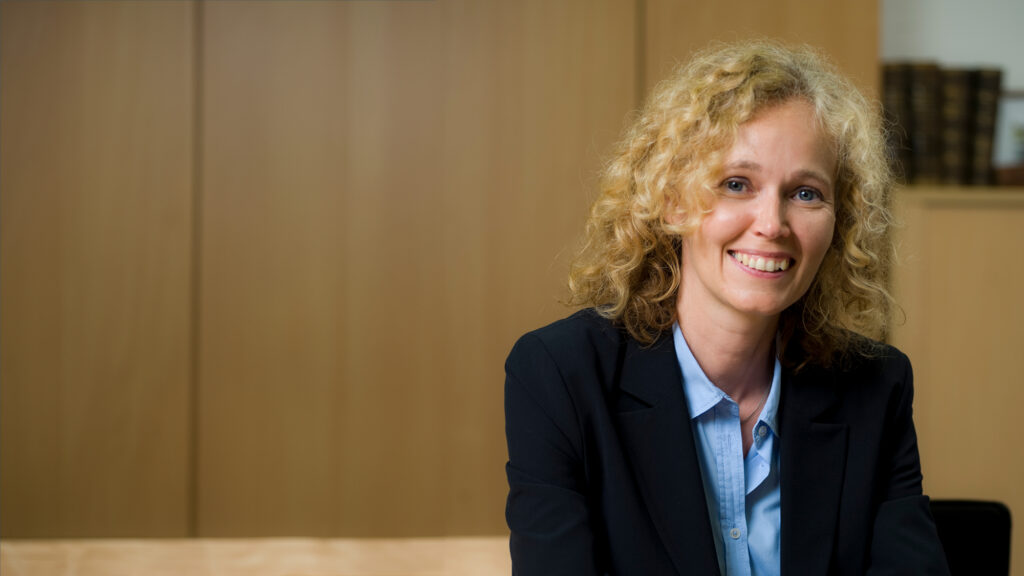“Sideways Is the New Up!”

Technology brings disruption to all sectors of the workforce. However, many HR departments continue to use traditional, outdated tools and policies to recruit and oversee the company workforce. Why?
Kelley Steven-Waiss: As a former CHRO and practitioner, I have to say that a lot of HR professionals are very comfortable with their processes, programs and best practices. They want to adopt new ways of working, but they do not know how to change the foundational practices to make that new way of working successful. To give you an analogy: Do you know that toddler toy from Fisher-Price? It’s a yellow box with various cut-outs of different shapes in it. Circles and squares and triangles. The toddler is supposed to fit three-dimensional circles, triangles and squares into the right places. The problem is that they’re usually not very successful. So what do they do? They get frustrated and throw the toy across the room. The yellow box represents the foundation – the best practices, career architecture, learning and development, and other recruiting practices – that are long-established HR department practices. But they try to take this new way of working or new process and force it into an old paradigm or foundation, and it doesn’t work. You have to be willing to change that foundation.
Edie Goldberg: Yeah, I love that analogy, Kelley. I think that HR has been using a lot of technology to automate existing processes. They have not used technology to fundamentally rethink their approach to work, and therein lies the problem: New technologies genuinely allow us to do things entirely differently. And until we get rid of the old processes, we aren’t going to make advancements in productivity, etc. Additionally, many HR executives are very comfortable with what they know. But what we talk about in The Inside Gig is a new talent operating model. It gets to the very core of everything we do in HR, which is around jobs. And moving away from that scares a lot of people.

So, fluid teams trying to be more agile within an organization are usually incompatible with ancient HR practices?
Edie Goldberg: Yes. We have to let people poke their heads up and come out of their box and bring their full selves to work – and all of their skills. This is the very foundation of the new talent operating model we propose. Companies need more elasticity around the concept of a job. We need to think more in terms of the skills that employees bring to their organization and leveraging them outside of that little box that we have put them in. Career moves in hierarchical organizations always were “upwards” rather than sideways – but this effectively locks most of the talent into silos.
Kelley Steven-Waiss: We must get to focus on progression versus promotion. To do so, we have to define what progression is and, then, we have to put incentives in place for advancement that is lateral versus vertical. Ask yourself: Why do people want to climb a ladder? It’s because they want to progress. It’s because we’ve attached things to progression like more pay, more prominent titles. If we can turn that around and say: Let’s connect a new element of compensation to reskilling and upskilling yourself – a lateral move, which gives you more skills – we’re allowing for that same benefit of progression, except it’s for moving sideways. Then, more people will be willing to move sideways if they feel that sense of progression. So net-net is:
We have to redefine what progression is and attach incentives to it. We need to show that sideways is the new up!
Kelley Steven-Waiss
But is this what employees also want?
Edie Goldberg: A few years ago, I did an extensive study in career management to understand what employees want. And what they want is new experiences that build skills. They say “career advancement” because that is the only model that they know. Today, with all the technological advancements and the disruptions that we’ve had in business, that makes less and less sense. Your future job might not even exist today! The skills that we need for the future of work are evolving faster than ever before. And so, looking up is not going to be very helpful because that next best career opportunity that might catapult your career is likely to be on a tangent off to the right or the left. It’s about applying your skills in new ways to go after skills of growing importance within the company. Career success today is more about a collection of experiences that lead to the next opportunity, rather than merely advancing on one specific career ladder.
That sounds very convincing. But going back to the actual HR setting: Does that pay off for HR? I mean, this model, in the beginning, adds to the cost side. HR is spending money on training, spending money on upskilling. In addition to these efforts, you ask them to spend even more money on people who move sideways. What does C-level say when HR presents the new cheque for months and years?
Kelley Steven-Waiss: That’s just another skill set that is not always embedded in HR: how to persuade the business to move in the new direction. It’s about asking and answering the relevant questions: What is the return on investment if we change our talent strategy? How do I highlight a – possibly burning – platform for change when I see that the organization will lose competitive advantage because the skill supply falls below the demand? How do I establish the metrics that show success as the organization implements new talent development models that save the company money while improving engagement, lowering turnover, etc. If you’re going to talk to a COO, a CFO and a CEO, they’re mostly going to care about organizational performance and productivity, cost savings and strategic moves. It may cost more in the beginning, but you can definitely show that it pays off. And then it makes sense for everyone, not just individual departments like HR.
Edie Goldberg: Before the pandemic hit, our talent shortages were at an all-time high over the past decade. Globally, 54% of companies could not execute their business strategy because they didn’t have the skills they needed to perform. When companies are looking forward and thinking about this new strategy and people want to skill up, it’s really about communicating: What are the business-critical skills? What are the capabilities that we need to be developing for the company’s future? Remember:
Skill sets are shifting quickly. Therefore, the need to develop people internally is more important than ever before because you’re not going to buy that talent. It’s not only costly if you succeed in hiring – in most cases, the needed talent simply isn’t available because it’s in short supply in the labor market.
Edie Goldberg
The ideas of inside gigs that we share in our book are about giving people the experiences that build new skills that help their career and help them develop the capabilities they need to execute on the business strategy.
Kelley Steven-Waiss: It is about understanding supply and demand of your skills supply chain. There is a business issue and opportunity cost of not being able to create this new way of working ensuring the longevity of the organization. To act, you have to identify where your skills gaps are when it comes to executing strategy. And then ask yourself: How do we stay in front of this instead of being victimized by it?
But not, as perhaps in the past, with big five-year plans and rigid strategies, but step by step – continually testing what works in an organization’s unique environment and adjusting accordingly?
Edie Goldberg: Yes. We have become a knowledge worker economy in general, globally. And how you manage and deal with knowledge workers is very different than how we traditionally dealt with employees strictly in a manufacturing arena. Knowledge workers want to be inspired. They are probably more profound experts than most of their managers. So, they need a very different way of managing. And we need to understand that if you’re valuing people for – let’s say – their ability to write and make beautiful prose, you need to let them do what they do best and concentrate on providing an enabling structure as a manager. Not boxing them in, that’s the difference.
Kelley Steven-Waiss: When it comes to implementing change, we need to start at the leadership level. Leaders need to start prioritizing talent investment like they do with their supply chains. We need to ensure that a focus on talent is embedded in the company’s core values. Because you get a lot more mileage when you say, for example, the company’s core value is to learn fast. Then, of course, when investments are made as a part of a learning organization and employee development, everyone understands the “why.”
After adopting this crucial mind-set, agile organizations must keep track of a whole lot of things. First of all, you have to assess the organization’s current talent. But how do you do this? Do you ask or investigate the workforce’s CVs again? Or do you ask co-workers who is helpful or not? What’s the best approach here?
Kelley Steven-Waiss: First, you have to be able to see the skills of individuals in 360. And that involves partially how they will assess themselves and how they will be assessed. So, when it comes to self-assessment, the following four questions are critical: What can I demonstrate? What do I aspire to learn? What can I infer in the flow of work by the work I am doing? And what do I declare I can do? So those are the four. Declare, demonstrate, infer and aspire. That type of information will tell us a lot about individuals and enable us to move them to the right opportunities where they are engaged and can contribute.
And when it comes to validating skills?
Edie Goldberg: We’re still working out how to validate skills because validation of skills as a global standard doesn’t exist yet. I think there’s a little bit of triangulation on data points. So, for example, you might self-report that you have specific skills. And remember: You are an employee, not someone unknown trying to get a job. If you self-report skills that you don’t have – you would very quickly get embarrassed within your organization.
What we have found in any of the companies that we’ve worked with or interviewed is that people do not overexaggerate the skills they have. If anything, people underreport their skills.
Edie Goldberg
To validate what someone tells you, ask their colleagues. For example, at the end of a project, ask a project leader, maybe project peers, to rate someone on some of the skills they used in that project. You get confirmation from other people that have worked with you, that have seen you demonstrate those skills. Validation comes from looking at that information from multiple perspectives.
Kelley Steven-Waiss: Same story for performance management in general. HR has traditionally held performance management once a year. You’ve seen it evolve. Remember the yellow box, the old way of doing things? Now, performance reviews have evolved into project-based work. Feedback becomes a real-time-thing, and that makes it more valuable for both sides.
Ok, first you get all these assessments and feedbacks. But, secondly, how do you then measure these against each other? You suggest setting up a digital platform to do so – just like the big online freelance work platforms. So, is there a DIY-solution here you can recommend?
Kelley Steven-Waiss: In HR, we worry about both the what and the how. On the what: Does somebody have the competence? On the how: How do they work? Are they collaborative? Are they easy to work with? You should assess this in the flow of work, not by setting up yet another evaluation system. It must be intuitive, easy, straightforward. So, here’s your DIY: Ask each project participant to be assessed and assess each other, “Would I work with this person again?” And the project leaders: “Would I hire this person again?” That is all you need to know. Then, make the process digital and track these answers. And trust me: If you’re good at what you do and you’re great to work with, you’re going to get on a lot more projects. And, likewise, if you’re an outstanding leader, you’re going to be able to lead more projects.
Edie Goldberg: I fully agree. I am actually in the middle of writing a book chapter on performance management and why it’s broken, and how it has to change. Ultimately, those kinds of things come down to a manager’s skill and their ability to have a conversation. It’s not about a form, about a process, about analog or digital. It is much more about teaching people how to communicate about performance. If you’re trying to improve performance, then getting all this different information on the various projects that someone is working on helps you understand how that person performs in a larger context and provides it for the system. It’s not about feeding data into a database. It is more about feeding information to the employees about how they can improve or achieve their goals. Many companies are too focused on the documentation and not enough on the dialogue.
So, we’ve got the talent together, it’s well documented, and we’ve laid the foundation for a vibrant, helpful culture of learning and working. What tends to go wrong at this point?
Kelley Steven-Waiss: Who will win or lose in this new way of working depends on a change of mind-set. It’s about how well both managers and the workforce adapt to this way of working, and it is not the technology that’s going to be the critical driver. It is how well a new talent operating model is embedded: the yellow box – I’ll keep using the analogy because we’re familiar with it. How well do we create the new systems and processes around this that are cultural? How do we get leaders to have a mind-set shift about talent owned by the company versus talent owned by the manager?
In this regard, what did the pandemic change?
Edie Goldberg: We wrote the book before the pandemic, and COVID-19 made even more visible what we already knew. Companies all of a sudden realized that they needed to know what they have. The pandemic caused companies to shift and change how they were managing talent and what people were doing. Mainly because so many in the retail environment had to shut down, and people had to learn to do things differently. And what they realized is, “Oh my goodness, we have people who have all kinds of skills we knew nothing about.” And when they started trying to put things together with band-aids and tape and scissors and asking people, “Who can do this, because we need somebody to work on this project…?” then 50 hands go up. They had no idea they had that capability available to them within their organization because they did not know the goldmine of talent that they were sitting on. Because they put everybody in a box called the job and they didn’t see anything else about those people, their interests, their passions, their past experiences.
Kelley Steven-Waiss: To use another analogy, the pandemic forced everyone to all of sudden “start using their left hand.” If you’d have told everyone, “You’re no longer allowed to use your right hand. You must write with your left,” you could get groaning and, “No, I won’t be able to do that.” But when you’re forced to do something, it’s incredible how suddenly innovation occurs. It’s amazing what light bulbs go off for you as a company. It’s fantastic when you realize, “We can do without offices. Oh, we can do without getting on airplanes. Oh, we can tap existing talent and get people to move around.”
That mind-set shift is tough, but the change made possible by the circumstances.
Kelley Steven-Waiss
But in the end, I think we cannot rely on a pandemic to spark those ideas. How about more positive examples, best practices, and success stories to promote change – are these powerful enough to drive progress?
Edie Goldberg: Well, the accelerator that COVID-19 was, forcing us all to write with our left hand simultaneously, broke open new ways of doing things. And I do think this will be the catalyst for a lot of change. One of the fundamental principles in The Inside Gig is about talent sharing across organizational boundaries. Kelley and I proposed that in the future we see companies sharing talent across their business ecosystem partners. One example we share in the book is about Disney and Siemens. Disney and Siemens are business ecosystem partners. Siemens provided the technology to build Disney World rides and attractions, and Disney promoted some Siemens medical products on their TV shows. So, they already had a symbiotic relationship. When Siemens went to market a hearing aid to children, they realized they had no marketers with expertise in that field. They asked the question, “Who’s the best marketer to children?” Of course, the answer is Disney. So, they seconded an employee from Disney to work on marketing the Siemens product. And it was a huge win-win for both organizations.
Kelley Steven-Waiss: What we saw happen in the crisis surrounding COVID-19, was, suddenly, companies started sharing talent across their ecosystems because some part of that ecosystem had shut down. And other parts of those ecosystems just lit up like a rocket and quickly needed massive amounts of talent. And companies started sharing furloughed employees across their organizational boundaries. We give examples in the book of some companies that were doing this before, but we see a more significant acceleration because of the pandemic.
Let’s wrap it up: We assessed talent, kept track of it, avoided the booby traps of non-adoption, and even broke most of our silos, department-wise, maybe even markets. Final question: How much silo is necessary to feel safe at work? And how much liberty can you grant without risking a break in organizations or an organizational ecosystem?
Kelley Steven-Waiss: First, giving employees choice is not synonymous with creating chaos. We must allow people choice. Human beings thrive in choice, and they dwindle in uncertainty. People need to know that they can grow and change, and we need to find a way to enable that. So:
Technology will be an enabler to give us the insights to allow for mobility at scale without creating many issues. More mobility will equal more engagement, less silos and greater levels of contribution.
Kelley Steven-Waiss
Edie Goldberg: I think it’s not about safety. It’s about community. We work in our silos, and those are our people, that’s our tribe. We need to collaborate with people to build capabilities to improve our company. And those capabilities are always within our silo. Wrapped around it, there is a common purpose, but we have various communities for different reasons, and some are very purpose-driven, and some are about building the capabilities that we have. We aren’t talking about completely doing away with hierarchical structures. That’s not going to hold, and that’s way too radical of a concept…
…but?
Edie Goldberg: We are talking about creating fluid structures to do the day-to-day work and allow those more formal structures to provide guidance and strategy. It’s about multidisciplinary teams that come together to work on solving a particular problem – yet people still have their home base – their core job, team or department. They have their community where they can build capabilities, and thrive.
About the authors
Edie Goldberg is the founder of E.L. Goldberg & Associates. She is a nationally recognized expert in HR strategy, talent management, and organization effectiveness. Kelley Steven-Waiss is the founder & CEO of Hitch Works Inc., a talent mobility platform that uses artificial intelligence and machine learning to match project-based opportunities to internal employee skill profiles. They are the authors of The Inside Gig.








